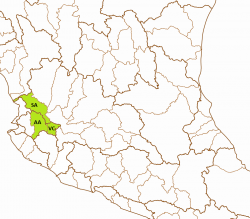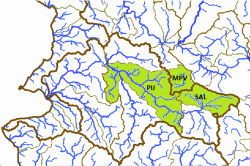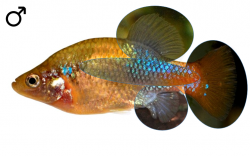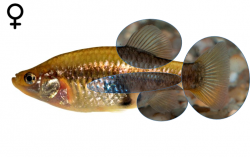- HOME
- WHO WE ARE
- NEWS AND DATES
- GOODEIDS
- PHYLOGENY
- ARTIFICIAL KEY
- GOODEID SPECIES
- BIOLOGY
- ENVIRONMENT
- CONSERVATION
- PROFUNDULIDS
- MEMBERS AREA
"Xenotoca" doadrioi
English Name:
San Marcos Redtail Splitfin
Mexican Name:
Mexclapique (erronously: Mexcalpique) de San Marcos
Original Description:
Holotype:
Collection-number: Colección de Peces de la Universidad de Michoacán, Cat. No. CPUM-9589, CPUM-T-41530
The Holotype is an adult male with 41 mm standard length, collected on June the 17th, 2010. Together with the Holotype were collected 30 Paratypes of both sexes and deposited in several institutes (Cat. No.'s CPUM-5543, CPUM-T-11929-11933; MNCN_ICTIO-290.844-290.847; CNPE-IBUNAM-20839).
Photos of the Holotype and a female Paratype of "Xenotoca" doadrioi:
Terra typica:
Etymology:
The species is named for the "prestigious ichthyologist Dr. Ignacio Doadrio, Museo Nacional de Ciencias Naturales, Spain, who has strongly contributed to the study and knowledge of Mesoamerican fish diversity".
This species belongs to an undescribed genus, but until the changement has happened, it stays integrated in Xenotoca. The genus Xenotoca was erected for Characodon variatus by Hubbs and Turner in Turner, 1937, because "this species differs from Characodon (lateralis) in numerous internal as well as external features. Characters distinguishing Xenotoca from Characodon involve the ovarian anatomy, the form and structure of the trophotaeniae, and some superficial features". The generic name can be derived from the ancient Greek with the word ξένος (xénos) meaning strange and and τόκος (tókos) offspring. Xenotoca can therefore be translated with "a strange type of offspring".
Synonyms:
Characodon eiseni Rutter, 1896
Characodon variatus Regan, 1907
Xenotoca eiseni Fitzsimons, 1972 (partially)
Distribution and ESU's:
The San Marcos Redtail Splitfin is endemic to the Mexican federal state of Jalisco. It was historically known from springs (e.g. Almoloya, San Sebastián) and dams of the endorheic Laguna de Magdalena basin including the lagoon itself, from headwaters of the Río Chiquito near the town of San Marcos (Arroyo Tezontete headwaters), including the Presa Limoncito (Oconahua dam), a Río Ameca affluent, and probably from the Río Salado, a Río Ameca affluent about 15km W of Guadalajara. The affiliation of the last subpopulation to "Xenotoca" doadrioi needs to be verified, but is very likely (Lyons, 2018, pers. comm.). The type locality is a small and permanent pond just in the east end of the Hacienda San Sebastian, with around 6,000 m2 fed by a spring. Other known locations in the area are Almoloya spring, Estancia de Ayoles reservoir, Oconahua Dam around 3km west of Oconahua village, and the highly perturbed and seasonally affected streams along the federal road number 4, between Etzatlan and San Marcos Village, known as arroyo San Marcos and arroyo de la Granja Sahuaripa, but the last two locations have not yielded specimens since 2006, and in an extensive survey in 2015, these localities were found to be totally dry or full of Pseudoxiphophorus bimaculatus (Heckel, 1848) when water was present. As the species (probably) occurs in three separate drainages, three subpopulations, the Laguna de Magdalena subpopulation (type subpopulation), the San Marcos and the Upper Río Ameca subpopulation can be inferred. The bold names are the ones officially used by the Instituto Nacional de Estadística y Geografía; nevertheless, other ones might be more often in use or better known and therefore prefered.
ESU ist short for Evolutionarily Significant Unit. Each unit expresses an isolated population with different genetic characteristics within one species. ESU's can be defined by Molecular genetics, Morphology and/or Zoogeography and help in indicating different phylogenetic lineages within a species. The abbreviation for an ESU is composed of three letters of the genus, followed by the first two letters of the species name and an ongoing number in each species.
In "Xenotoca" doadrioi, it is not possible to distinguish different ESU's, so there is only one recognized: Xendo1 (before: Xenei5).
The left map shows the Río Santiago-Aguamilpa (SA) basin from the Hydrographic Region Lerma-Santiago, and the Presa La Vega-Cocula (VC) and Río Ameca-Atenguillo (AA) basins from the Hydrographic Region Ameca on a Mexico map. The San Marcos-Redtail Splitfin is known from the endorheic Laguna Magdalena-Laguna Palo Verde subbasin (MPV), Río Santiago-Aguamilpa basin, and from adjacent borderlands belonging to the Río Ameca-Pijinto subbasin (PIJ). Following John Lyons, Redtail Splitfins in habitats of the upper river sections of the Río Salado subbasin (SAL) belong to this species as well, which seems to be very likely. Therefore it is considered on the right map of subbasins here:
Status :
International Union for Conservation of Nature (IUCN): Critcally Endangered
Distribution and current conservation status of the Mexican Goodeidae (Lyons et al., 2019): Endangered/declining: „This species was shown to be genetically distinctive by Piller et al. (2015) and was recently separated from X. eiseni (Domínguez-Domínguez et al., 2016). It is found in the San Marcos drainage of the upper Ameca River Basin and the adjacent endorheic Lake Magdalena basin. Since 2000, it has disappeared from many locations due to water diversions and groundwater pumping that have eliminated many springs and small streams, and probably also from competition with or predation by the non-native Pseudoxiphophorus bimaculatus (Poeciliidae), which appears to have displaced X. doadrioi in some places. Only a handful of populations of X. doadrioi persist.“
NOM-059-SEMARNAT-2010: no categoría de riesgo (no category of risk)
Habitat:
This species seems to be highly adaptable to variable habitat conditions. At the type locality, the species inhabits an area with turbid water, and was collected in a shallow water no more than 1.5 m deep. The pond is no more than 3 meters at its deepest part; the bottom is comprised of mud and gravel, and no water plants are present. Other fish species collected in the area were "Xenotoca" cf. melanosoma, Goodea atripinnis (Jordan, 1880), Poeciliopsis infans (Woolman, 1894) and the introduced Xiphophorus variatus (Meek, 1904) and Oreochromis sp. Historically, other species reported from this pond include Algansea amecae (Pérez-Rodríguez, et al. 2009), Moxostoma austrinum (Bean, 1880), and Allotoca maculata (Smith & Miller, 1980), but all of these species have not been collected in the area since 1970. In the El Moloya Spring, the species inhabits clear water with gravel to muddy bottom and water plants and this pond is used as a swimming pool. Other species inhabiting this pond are "Xenotoca" cf. melanosoma, Zoogoneticus purhepechus (Domínguez-Domínguez et al., 2008), Ameca splendens (Miller and Fitzsimons, 1971), Goodea atripinnis, Poeciliopsis infans, and the introduced Oreochromis sp. In Oconahua Dam, the water is turbid and contains a muddy bottom and with few water plants. Other species collected include "Xenotoca" cf. melanosoma, Goodea atripinnis, Poeciliopsis infans, as well as the introduced Lepomis macrochirus (Rafinesque, 1818), and Cyprinus carpio (Linnaeus, 1758). The San Marcos stream is a seasonally fluctuating stream that is dry for most of the year, but when water is present the surface of the stream is totally cover with Eichhornia crassipes (Martius), Thypa sp., and Cyperus sp. The water at this site is highly polluted by organic matter and is turbid, whereas the Sahuaripa stream is an irrigation channel totally modified and fed by a water pump; in 1999 and 2002, the species collected in bothplaces included "Xenotoca" cf. melanosoma, Allotoca maculata, Goodea atripinnis, Poeciliopsis infans, and Oreochromis sp. For the 2006 survey, Allotoca was not collected; in the 2015 survey only Pseudoxiphophorus bimaculatus was found.
Biology:
Not much is known about its biology in nature. The reproductive period seems to be similar to the one of the closely related "Xenotoca" eiseni with fry in late spring or longer. On a survey of the GWG in February 2016, the group found this species at the type location in turbid, milky and murky water, where it was sparse. The group could not detect any fry, and the smallest specimens were about 3.5cm TL. They found the species also in the outlet, a shallow milky creek, covered by trees above mud and branches. At Almoloya, the same group was able to find only one male with the water being turbid and muddy. The species seemed to be extremly rare at this location.
Diet:
From its cooccurence with "Xenotoca" cf. melanosoma, which is mainly carnivorous, a more omnivorous feeding habit with plant material forming the greater volume of food, similar to the related species"Xenotoca" eiseni, can be inferred. The San Marcos Redtail Splitfin is replacing the Redtail Splitfin in the in areas east of Nayarit.
Size:
Maximum known standard length is 47mm (Domínguez-Domínguez et al., 2016)
Colouration:
When alive, the colouration varies with respect to the age and sex of the organism. Mature females display a general brownish colour. Most mature females display dark blotches along the central part of the body, being bigger and conspicuous at the posterior half of the body; these blotches are formed by small black spots. Some scales show iridescent silver colourations in the body, being more evident in the postorbital and opercular region. Some females possess a dark stripe that runs along the middle part of the body, from the opercle to hypural plate. Scales are frequently rounded at their exterior margin by small black spots; a black blotch is present in the posteroventral region, between the pelvic and anal fins, which varies in depth and width. Juveniles have the same colouration as females, but when they reach ±20 mm, they begin to differentiate to adult colouration. Males show the most colourful form of all "Xenotoca" - species; this varies depending of the size and reproductive stage. In general, the caudal peduncle has an orange to almost red colouration combined with iridescent blue scales, the intensity and coverage of each colour along the caudal peduncle is highly variable, some specimens show a blue or green to dark blue or green scales in the anterior part of the peduncle, the blue or green colouration extends to the origin of the dorsal fin, and also the intensity and coverage is highly variable, the caudal fin and frequently the anal and dorsal fin also have orange to red colouration in the base and sometimes the dorsal fin shown a dark colouration in the base. The portion of the body from the origin of dorsal and anal fin to pelvic or pectoral fin is pale in colouration, with grey to yellowish coloration, in the pre-ventral region. Orange to red colouration exists frequently and extends to the inferior part of the head. Just up to the pectoral fin there is a black blotch with iridescent scales that also is highly variable in intensity and size. There Is also blue iridescent colouration in the opercle and in some scales along the body. The colouration of preserved specimens varies with respect to fixation and time since fixation, but in general, female specimens preserved in 5% formalin possess clear brownish colouration. The blotches are less evident along the body, in larger females they are still present. Numerous dark small spots are found in all the upper half of the body. A silver stripe is present along the middle part of the body, being more evident in the posterior half. The dark blotch in the posteroventral region is still evident. The opercle shows a silver colouration. Males lose all colouration when preserved. The peduncle and pre-ventral region show a clearer brownish coloration. The rest of the body shown a more brownish dark colouration with numerous black spots distributed along the upper half of the body. Fins clear and unpigmented, a few specimens still show a dark blotch up to the pectoral fin and the scales are rounded by a numerous black spots.
Sexual Dimorphism:
Males and females of the San Marcos Redtail Splitfin are easy to distinguish. A safe characteristic is the Splitfin in males, means the for Goodeinae typical mating organ formed by a notch after the first seven shortened rays of the Anal fin. Additionally, male "Xenotoca" doadrioi have a bigger Dorsal fin than females. The difference in colouration is clear and very distinct. While females are simply brown or brownish grey with a middle line broken into darker blotches posteriorly, clear fins and a small gravity spot, males have a typical red caudal fin with the colour extending on the caudal peduncle. The following section of the posterior half of the body is iridescent blue, at least on the upper half of the body to the Dorsal fin, followed by a golden zone, this again followed by a grey one extending to the head. This grey mingles with blue scales and both zones, the grey and the blue can show black or dark areas giving the males the appearance having a golden saddle. Males have a yellow to orange belly and can display a black blotch in the Dorsal fin, but the last character can't be found in all individuals.
Remarks:
"Xenotoca" doadrioi is known only from small springs and a dam in areas highly impacted by human activities that have been strongly modified for irrigation. It has been extirpated from more than 50% of the known historical localities (Pedraza-Marrón, 2011). This species is found in small numbers in the three localities where it presently occurs, and these localities are under the influence of substantial irrigation pressure for agriculture. Introduced fish species pose a significant risk for the long-term survival of this species. It is recommended that is has to be considered as a species in danger of extinction.
The San Marcos Redtail Splitfin was the third and last species of Redtail Splitfins being held in aquariums. After the Redtail from Nayarit in the middle of the 1950's and the Tamazula Redtail dating back with the first fish arriving in Europe around 1976 or 1977, it was Alfred Radda who brought the first fish to Europe in 1982. They were called Goldsaddle or San Marcos - eiseni since then, being seen as most colourful variety of this species. With the description of "Xenotoca" doadrioi in 2016, a lot of people became confused and are partly still not able to address the species correctly. The admittedly minor differences in meristics are barely to see with the naked eye, so people try to see differences in colouration. Here the golden band or saddle is typical for doadrioi males. Though there is also a kind of band in eiseni and lyonsi, this band is indistinct and grey in contrast to shiny golden in doadrioi, and a yellow or orange cheek or belly is typical for doadrioi males as well. The Tamazula Redtail has the belly white or whitish and separated from the back quite clearly, in eiseni the separation to a lighter coloured belly is indistinct, and the belly is usually not white. The original Redtail, "Xenotoca" eiseni, is honestly spoken optically almost not to distinguish from lyonsi. So, knowing the origin of fish and correctly passing it over to other keepers and breeders is extremely necessary in most of the Goodeid species, especially in the Redtail-group. Otherwise it results in hybrids and makes the whole kept population worthless for conservation efforts, and even dangerous when being passed over to the next breeder with wrong location data.
Husbandry:
Looking on the biotopes of "Xenotoca" doadrioi, they suggest the species may prefer a habitat with moderate to swift current, structured with rocks, roots and small areas with dense submerse vegetation. Intraspecific aggession is sometimes observed, mostly between males of same size. Fry is usually not eaten, but it may depend on the quantity and quality of food and on the number of places to hide. When several different stages of juveniles occur, fry will be be neglected, so it makes sense to add separate brought up fry to the group with a size of 2 to 2.5cm to provide these stages and get a flock breeding colony.
The recommended tank size is at least 150 liters, bigger tanks with a generous base and little height (25cm are enough) are better for sure. A bit with roots and/or rocks structured tanks with few patches of dense submerse vegetation in the corners and bigger free areas to swim seem to do best with this species. The current should be moderate, especially as the oxygene level should be quite high (at least 8mg/l).
In the wild, adults of this species feed mainly from algae, aufwuchs, Crustaceans and insect larvae, so much light to help algae grow and feeding with vegetables and additionally fiber-rich middle sized food from animalistic sources will be best for this fish. In aquarium, it feeds very well from flake food, granulate and tablets, additionally freeze dried food like Brine Shrimps is eaten greedy. The species is anything else but shy.
Concerning water quality, this species is in need of bigger water changes (60-80% every week) like most of the Goodeids, especially spring and river inhabiting species. Therefore an automatic water changing system can be helpful. Otherwise, in combination with constant temperatures higher than 25°C, fish may get sick, lose resistance against diseases and age too fast. So for keeping the strain healthy and strong, give the fish a rest during winter time with temperatures lower than 20°C for 2 or 3 months so they stop producing fry. In spring, when the temperature slowly increases, they will start spawning at 20 or 21°C and won't stop until it gets colder again or when it gets too warm (25°C).
This species does very well when is kept in the open from spring to fall, starting when the water temperature by day exceeds 17°C and cold periods are no longer expected. Bring them out in the early afternoon, the time of the day with the highest water temperature. During the warm summer, reproduction will stop and may occur again in fall. Bring the fish in before the water temperature deceeds 17°C by day and keep them cool for the first days, then slowly raise the temperature but try to stay below 20°C over the winter time.
Populations in holding:
Here each species are assigned populations of fish in husbandry and in brackets aliases of these locations to assist in identifying own stocks. Each population is assigned a unique Population-ID, composed by the ESU, the subbasin where this population is occurring (three capital letters) and a unique location identifier.
Populations in holding:
1. Xendo1-MPV-SSeb
Population: San Sebastián (aka Hacienda San Sebastián)
Hydrographic region: Lerma-Santiago
Basin: Río Santiago-Aguamilpa
Subbasin: Laguna Magdalena-Laguna Palo Verde
Locality: Arroyo Corta Pico, at the dam N of the Hacienda San Sebastán
2. Xendo1-PIJ-SMar
Population: San Marcos (aka Granja Sahuaripa, San Marcos Pond, San Marcos Road, San Marcos 1 & 2)
Hydrographic region: Ameca
Basin: Río Ameca-Atenguillo
Subbasin: Río Ameca-Pijinto
Localities: several affluents of the Canal del Bajío and ponds 1-1.7km E of San Marcos
















